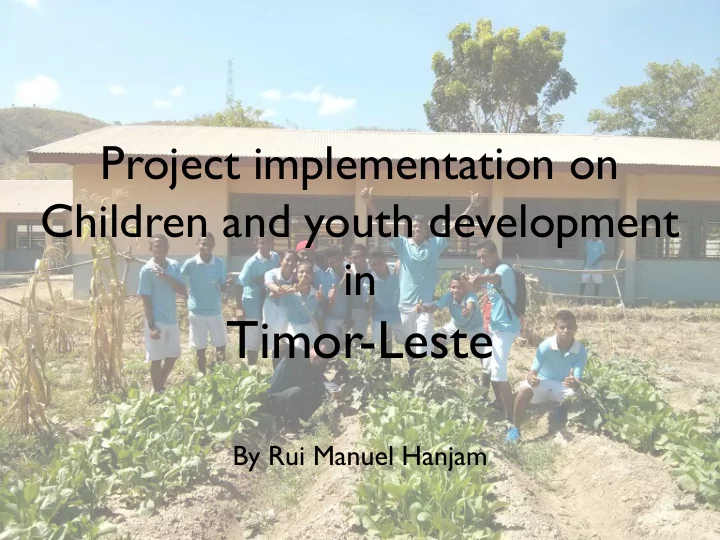

Project implementation on Children and youth development in Timor-Leste By Rui Manuel Hanjam
Outline 1. Background of country 2. Education system 3. Historical Background of HRP Project 4. Objectives 5. Pilot Sites 6. Main Activities 7. Results 8. Lessons learned/Good practices
Background of country • Population: 1.2 million • Approximately: 17,000 km2 • Official Language: Protugese, Tétum • Working Language: English, Bahasa (Indonesia)
Education System • Compulsory(Basic) education: 9 years • General Secondary education and Technical/vocational education: 3years Medium of Instruction Portuguese and Tétum Number of School Basic Education Public 10,077 / Private188 = 12,065 schools Secondary Education (Senior High School) Public 58 / Private 40 = 98 schools Technical Vocational 27 schools Number of Students Basic Education: 384,040 students (temporary number) Secondary Education: 48,708 students Number of T eachers 10,258 teachers
The School Agriculture Initiative • New curriculum • Initiative of Highness Royal Project: “Zero Hunger Challenges” • 2 schools pilot: Hera and Akanunu Primary School near capital Dili “ Our VISION is that all Timorese children should attend school and receive a quality education that gives them the knowledge and skills to lead healthy, productive lives and to actively contribute to our nation’s development …”
Historical Background of HRP Project Realization the visit of Princess to Timor Leste 1. Invitation from Princess Office to send a delegation to 2. Thailand for comparative study Design the project and presented to HRP 3. Ministerial Meeting (Education, Health, Agriculture, and 4. Commercial Industry&Environment) and Thai Embassy Coordination Disseminations 5. Implementation 6.
Objectives 1. To support implementation of school feeding programme through school agricultural production. 2. Utilize space of school to carry out productive activities in agriculture for partially maintaining food security. 3. Served as a learning center for students to prepare skill in agriculture in the future. 4. To integrate and cultivate the values of work ethics, perseverance, hygiene, environmental awareness, cultural conservation, business culture and self-reliance
Project Sites Primary School near capital of Dili • Hera • Akanunu
Main Activities • Mobilization of parent and teacher association for the introduction of the project • Land preparation (Community, Students and Ministry of Agriculture) Preparation • Seeds distribution (Ministry of Agriculture and Thai Embassy) • Water installation and Cultivation • Children participation in the process of cultivation(Organic Fertilizer > Cleaning soil > Pouring water > Daily monitoring) Implementation • Harvesting • Consumption by the school feeding program and business Result
Main Activities Land preparation Cultivation Fertilizing Watering Harvesting
Results • Various of produce for consumption and business: vegetable (eggplant, potato, corn, spinach, cucumber, zucchini and fruit (watermelon) • Availability of agriculture product for securing school feeding program • Children start to grasp the knowledge of cultivation
Lesson Learned/Good Practices • Different line ministries involvement • The integration of the School Feeding Program, Nutrition Program and School Garden Projects, with agriculture and hydroponic system reduce the cost of vegetables for the School Feeding Program • The integration of agricultural activities • The process and the concept providing basic understanding of health and hygiene
Lesson Learned/Good Practices The importance of educating children at the early stage to understand agriculture and increase environmental awareness; Principle guidance for job creation Participation parents and teachers and community, deprecating the model to different schools and neighborhood The integration of the National Curriculum and local contents according to the needs of the specific reality is crucial.
Obrigado Thank you ขอบคุณครับ Arigato Gozaimasu
Recommend
More recommend